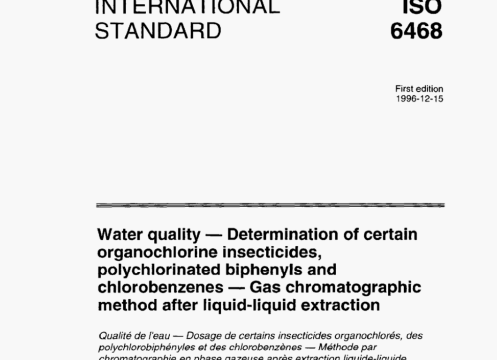ISO 6468 pdf download – Water quality – Determination of certainorganochlorine insecticides, polychlorinated biphenyls and chlorobenzenes – Gas chromatographic method after liquid-liquid extraction.
6 SamplIng and sample preparation
Take samples according to ISO 5667-1 and ISO 5667-2.
Collect the water samples in brown glass bottles cleaned as described In 5.14 (do not use plastics bottles) with ground-glass stoppers or with screw caps with PTFE liners, of nominal capacity 1 litre to S litres. Fill the bottles to 80 % to 90 %.
On sample collection, ensure that no interfering sub- stances enter the water sample, and no losses of the determinands occur. This is especially important when using plastics tubing with the sampling apparatus. If necessary, it shall be proved by control tests that no losses by adsorption occur. Glass and stainless steel devices sham preferably be used.
Check the pH. If necessary, correct the pH immediately after collection in order to be m the range pH 5 to
7,5.
It endosulfan is to be determined, take a separate sample and keep it under acidic conditions (pH 2) until extraction.
Do not place samples in close proximity to the cnricntrated insecticide or PCB or chlorobenzene solutions. Store In the dark at a temperature of approximately 4 °C prior to extraction.
Ensure that all samples are extracted as soon as possible (preferably within 24 h) to avoid decomposition of the compounds after sampling.
Halogenated hydrocarbons of low volatility and organochionne insecticides are relatively stable if transferred into an organic solvent. Therefore, it is permissible to store the dried solvent extracts in a refngeratoc at 4 C for up to two months. Evaporation of the solvent can still occur even under refrigeration. Extracts shall not be allowed to go to dryness and the volume of solvent shall be restored to the original amount before starting analysis.
7 Procedure
7.1 Sample pretreatment
Sample pretreatment is not normally necessary.
If the sample container is filled up to the ground-glass joint, shake and pour off 30 ml to 100 ml of the sample in order to obtain sufficient free volume for the subsequent addition of the solvent.
Measure the volume of the water to be extracted by weighang the bottLe before extraction and after emptying.
7.2 ExtractIon and separation
Use either of these two procedures fo extracton and separation:
— extraction in the sample container and separation in a separating funnel (7.2.1);
— extraction in the sample container with a magnetic stirrer or a high-speed stirrer and separation by a microseparator (7.2.2).
NOTE 7 Depending on the method used, varying recovenes and reproduclbdiUes may be obtained. The yields of the selected method should be checked by the laboratory
(8.3).
It is recommended to perform the extraction in the sample container Usually, a sample volume of about 1 litre Is used.
72.1 Extraction by shakIng the sampling bottle and separation In a separating funnel
Add 30 ml of the extraction solvent (4.2) to the sample (7.1) and shake for at least 10 mm.
Transfer to a separating funnel of suitable capacity (5.3) and allow the phases to separate.
Run the lower aqueous phase back into the sample container. Repeat the extraction twice with 20 ml to 30 ml of the extraction solvent (4.2).
Dry the extract using one of the following procedures:
— Pass the extract Through a drying column (5.9) containing anhydrous sodium sulfate (4.3), previously washed with the solvent (4.2) and collect the eluate in the evaporating vessel.
NOTE 8 II is advisable to wash the column with a further 10 ml to 20 ml podion of the solvent (4.2) to obtain a better recovery. Collect the washings In the evaporating vessel.
— Add anhydrous sodium sulfate (4.3) to the flask. Shake for 1 mm. Leave for 5 mm and decant the extract into the concentration apparatus. The sodium sulfate is washed with a further 10 rrd to 20 ml of solvent (4.2) and the washings added to the evaporating vessel.
ISO 6468 pdf download – Water quality – Determination of certainorganochlorine insecticides, polychlorinated biphenyls and chlorobenzenes – Gas chromatographic method after liquid-liquid extraction
